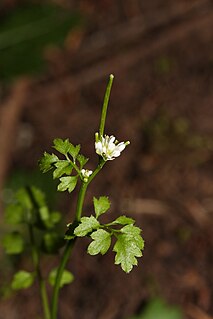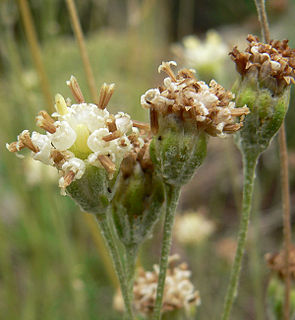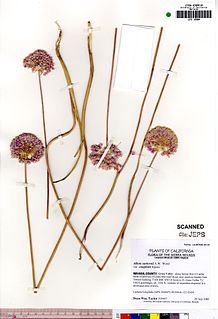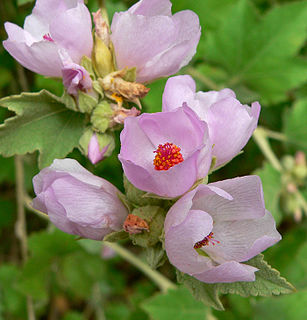
Cardamine is a large genus of flowering plants in the mustard family, Brassicaceae, known as bittercresses and toothworts. It contains more than 200 species of annuals and perennials. Species in this genus can be found worldwide, except the Antarctic, in diverse habitats. The name Cardamine is derived from the Greek kardaminē, water cress, from kardamon, pepper grass.

Anthocharis midea, the falcate orangetip, is a North American butterfly that was described in 1809 by Jacob Hübner. It belongs to the family Pieridae, which is the white and sulphurs. These butterflies are mostly seen in the eastern United States, and in Texas and Oklahoma. They eat the nectar of violets and mustards. They tend to live in open, wet woods along waterways, in open swamps, and less often in dry woods and ridgetops. This species is a true springtime butterfly, being on the wing from April to May.

Phacelia crenulata is a species of flowering plant in the borage family, Boraginaceae. Its common names include notch-leaf scorpion-weed, notch-leaved phacelia, cleftleaf wildheliotrope, and heliotrope phacelia. Phacelia crenulata has an antitropical distribution, a type of disjunct distribution where a species exists at comparable latitudes on opposite sides of the equator, but not at the tropics. In North America, it is native to the southwestern United States as far east as Colorado and New Mexico, and Baja California and Sonora in Mexico. In South America, it is native to southern Peru, western Bolivia, and northern Chile.

Draba cuneifolia is a species of flowering plant in the family Brassicaceae known as the wedgeleaf draba or wedgeleaf whitlow-grass. This annual plant is native to the southern half of North America where it grows in open, rocky fields and other disturbed areas. The plant forms a basal cluster of leaves, which are thick, widely toothed, and coated in stiff hairs. It bolts one or more erect stems which may approach 40 centimeters in maximum height. Each hairy stem bears an inflorescence of up to 75 small white flowers that continue at intervals down the stem as the stem grows in height. This family and its plants are easy to identify with its 4 petals and 4 sepals arranged like a "cross", either in an "X" or "H" shape, thus the name "Cruciferae". Mustards have 6 stamens usually 4 are taller and 2 are shorter. Fruits are either a long thin silique or short often rounded silicle.

Hymenopappus filifolius is a North American species of flowering plant in the daisy family known by the common names fineleaf hymenopappus and Columbia cutleaf. It is native to western and central North America from Alberta and Saskatchewan south as far as Chihuahua and Baja California.

Allium sanbornii is a North American species of wild onion known by the common name Sanborn's onion. It is native to northern California and southwestern Oregon. It grows in the serpentine soils of the southern Cascade Range and northern Sierra Nevada foothills.

Astragalus nuttallii is a species of milkvetch known by the common name Nuttall's milkvetch. It is native to California and Baja California, where it grows in the sandy soils of coastal habitat. This is a perennial herb forming thick, tangled clumps of hairy to hairless stems up to a meter in length. The abundant leaves are up to 17 centimeters in length and made up of many oval-shaped leaflets. The inflorescence is a large, dense body of up to 125 flowers, each around 1 to 1.5 centimeters long. The flowers are dull cream-colored and sometimes purple-tinted. The fruit is an inflated legume pod up to 6 centimeters long which dries to a papery texture and contains many seeds in its single chamber. One variety of this species, the ocean bluff milkvetch is endemic to the Central Coast of California.

Astragalus purshii is a species of milkvetch known by the common names woollypod milkvetch and Pursh's milkvetch.

Cardamine breweri is a species of cardamine known by the common name Brewer's bittercress. It is native to western North America from British Columbia to California to Colorado, where it grows in coniferous forests, particularly in wet bog habitats.
Cardamine occidentalis is a species of Cardamine known by the common name big western bittercress. It is native to western North America from Alaska to northwestern California, where it grows in moist mountain habitats.

Cardamine oligosperma is a species of Cardamine known by the common name little western bittercress. It is native to western North America from Alaska to California to Colorado, where it grows in moist mountain habitats.
Cardamine pachystigma is a species of Cardamine known by the common name serpentine bittercress. It is endemic to California, where it grows in rocky mountainous areas, often on serpentine and volcanic soils.

Chaenactis carphoclinia is a species of flowering plant in the daisy family known by the common name pebble pincushion. It is native to the southwestern United States and northwestern Mexico, where it grows in rocky and gravelly habitat, such as the California deserts. The species is found in southern California, Nevada, Utah, Arizona, southwestern New Mexico, Baja California, Sonora.

Leptosiphon nuttallii is a species of flowering plant in the phlox family known by the common name Nuttall's linanthus.

Malacothamnus fasciculatus, with the common name chaparral mallow, is a species of flowering plant in the mallow family. It is found in far western North America.

Minuartia nuttallii is a species of flowering plant in the family Caryophyllaceae known by the common names Nuttall's sandwort and brittle sandwort.

Silene douglasii is a species of flowering plant in the family Caryophyllaceae known by the common name Douglas's catchfly.

Trifolium depauperatum is a species of clover known by the common names cowbag clover, poverty clover, and balloon sack clover.

Cardamine angustata is a perennial forb native to the eastern United States, that produces white to pink or purple flowers in early spring.

Cardamine douglassii, the limestone bittercress or purple cress, is a perennial forb native to the eastern and central United States as well as the province of Ontario in Canada, that produces white to pink or purple flowers in early spring.

















